
SCROG growing can deliver superior yields for the indoor grower if you don’t mind the extra effort required to weave the branches into the SCROG net. The basic idea is to maximise the growth of as many bloom points as possible by keeping the canopy of blooms equidistant from the light source. Many SCROG growers find scrogging is the best way to maximise harvests from their grow room. When done correctly, you will harvest numerous heavy cannabis blooms all of which were grown under optimum PPFD (light) levels.
In this article, you’ll find:
You are watching: Growing cannabis with the SCROG method
- Screen of green (SCROG) definition
- SCROG first-timers useful tips
- SCROG method step-by-step guide
- How much can you yield when scrogging?
- Best cannabis strains suitable for SCROG
- How to SCROG with maximum yield
What is scrogging? SCROG step by step
Scrogging is a cultivation technique using a net (or ‘screen’) to act as a physical barrier to restrict vertical growth of the plant. The stem and branches are weaved through the net (or tied to it) and forced to grow horizontally instead of vertically. During the flowering phase all the blooms originate from the same height allowing the grower to keep each and every bloom in the optical ‘sweet spot’ of maximum PPFD light levels.
This SCROG method of training the cannabis plant may seem fiddly to the first time SCROG grower. But once you get used to SCROG growing you may not want to switch back. With quality lights and good nutrient management technique, you can get seriously heavy harvests from your grow room, often with fewer plants.
First time growing with the SCROG method?
The extra effort required with the SCROG method can deter growers from trying it. If you haven’t tried a cannabis SCROG before then maybe it’s time to give the SCROG method a try. Once you have set up your screen it’s only a few minutes of daily effort to tuck branches/stems underneath the netting. The results can be spectacular with heavy yields from low numbers of plants. It may change the way you grow in the future.
When and how to start scrogging cannabis plants
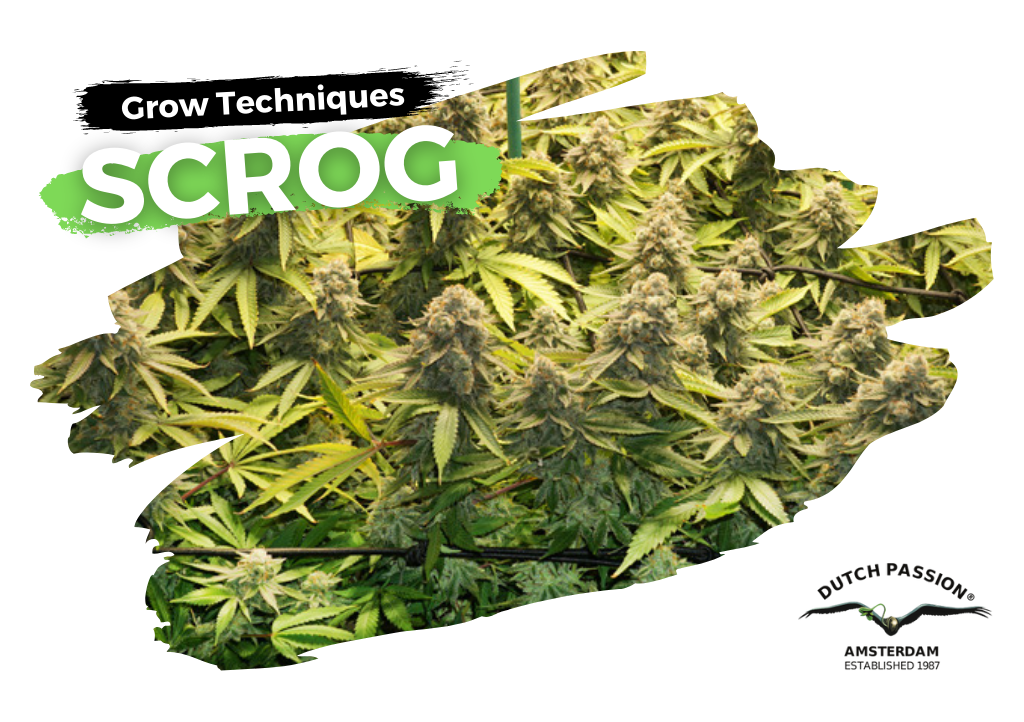
Many SCROG growers prefer to top (or FIM) their plants to amplify the bushy characteristics which are so well suited to scrogging. This means cutting off the main growing tip usually between the 3rd and 5th node during vegetative growth of feminised seeds.
You may wish to give the plant a week or two of additional vegetative grow to recover before switching the plant into flowering. However, if you need to fill a large screen with a single plant then you may wish to ‘veg’ your plants longer. Much depends on your personal circumstances.
Longer periods of vegetative growth suit growers who:
- Are growing low-stretch strains such as Indica dominant hybrid seeds. In order to fully fill a SCROG screen/net you may need to give longer periods of veg growth to these plants. Note that pure indica strains can be particularly tricky to work with in a SCROG. The overall plant structure isn’t suited, stretch is low, branches can snap and the broad figured leaves allow little light penetration.
- If you have a large SCROG net to fill, or if you are using just a single plant you may prefer to use longer periods of vegetative growth.
- If you have a large distance from the growing container to the screen/net you may prefer longer veg periods.
Conversely, those with a small screen, or those with very stretchy sativa varieties will lean towards shorter veg periods. Once you gain some experience in your own grow room you will soon be able to fine tune your grow method to reach new harvest quantities. If you want to know our very best yielding cannabis strains look no further.
Related posts: 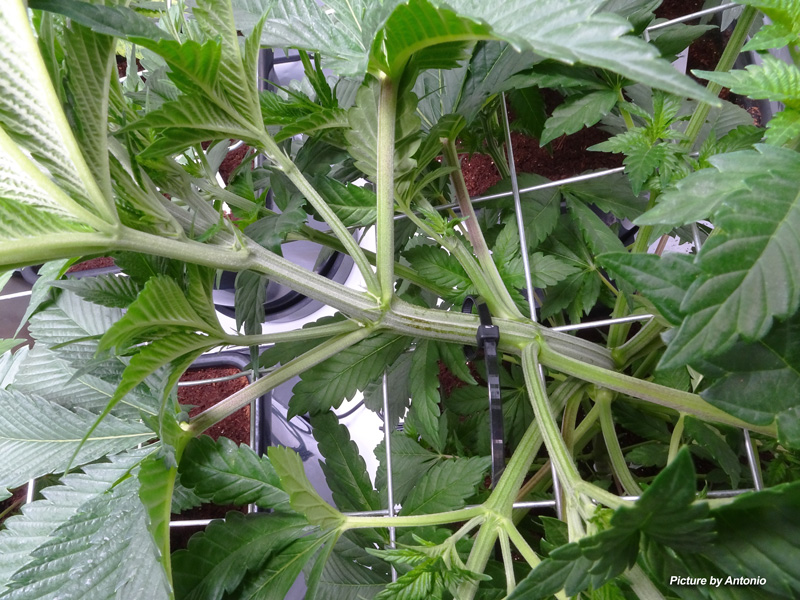 Top 5 best yielding indoor feminised seeds
Top 5 best yielding indoor feminised seeds  Top 5 best yielding outdoor feminised seeds
Top 5 best yielding outdoor feminised seeds
How many plants for the SCROG method
One of the beauties of the SCROG method is that you can use fewer plants than normal. A simple 1m x 1m indoor grow tent could produce a great SCROG result with just one good quality, well trained plant.

How much height needed for SCROG grow
One other advantage of scrogging is that you can grow in areas with restricted vertical grow space, such as cupboards/rooms with low ceilings. By adapting a low screen/net height you can train your plants to grow in places far too small for plants left to grow in their natural way.
With LED bar lighting you can get a crop in tents that are just 1.25-1.5m high, or even a little lower. These are often referred to as micro SCROG grows, and allow you to grow crops in areas with height restrictions. The SCROG method allows you to vary the distance between screen and plant containers according to your own needs.
One parameter which is fixed is the distance from the light source to the screen. This distance is fixed to allow the canopy of blooms to grow in the sweet spot for light intensity. One of the main advantages of scrogging is the ability to get as many of the blooms as possible growing under maximised light intensity levels.
Proper air circulation is vital for your cannabis plants
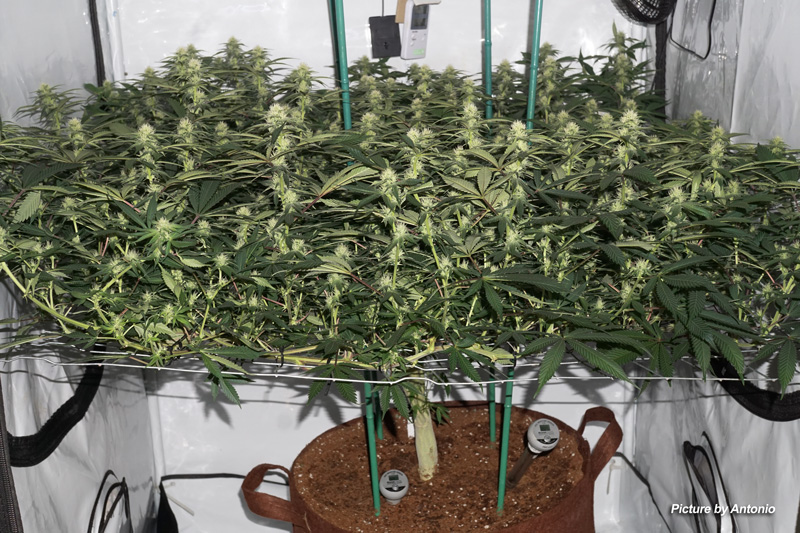
With a tightly weaved screen of cannabis branches, buds and leaves it can be difficult to ensure effective air flow through the canopy. Ensuring good air flow is important for good plant health, as well as minimising the chances of mould or bud rot.
Various techniques can be used to improve and optimise air flow. Many scroggers remove the lowest branches which have no chance of reaching the canopy and producing a bloom. By removing these lower branches you make it easier to circulate air below the canopy. Another technique is to use defoliation, especially in those varieties which produce an abundance of wide leaves. Removing these can allow more air to permeate the canopy as well as improving light penetration.
All SCROG growers place a high value on a powerful extraction fan to ensure air flow is sufficient. Often small clip-on fans are positioned in the grow room to blow air across the canopy of blooms. Some SCROG growers also have fans below the canopy blowing air vertically upwards through the canopy.
SCROG grow method and lighting (indoor LED vs outdoor SCROG)
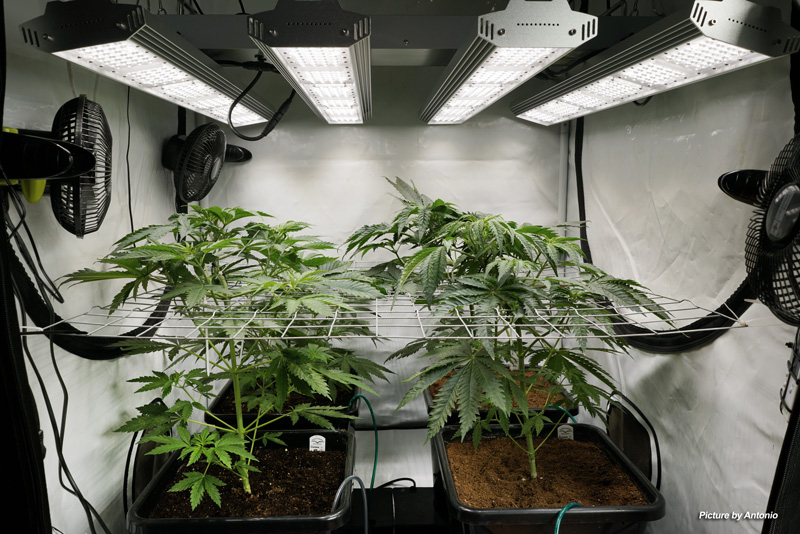
Many of those that have mastered the SCROG technique have often invested in the latest grow light technology – LED grow lights. Combining SCROG and LED are ways to maximise quality and yield from your grow room.
LED bar lights allow the canopy to grow relatively close to the lights. They also ensure an even light intensity from corner to corner of your grow area. Many of the best scroggers with flat screens find they get the highest THC levels and most pleasurable weed from LED SCROGs. LED also produces less heat than HPS grow lights which helps raise quality levels of the finished buds.
Those that SCROG with HPS lights, or those that use a powerful LED with a single point source (i.e. not LED bar lighting) may prefer to run a ‘half-pipe’ SCROG. A half-pipe SCROG has raised sides (like the seats in a football stadium). This allows the taller branches/blooms to be grown on the sides yet still be equidistant to the light source.
Outdoor SCROGs are popular with some growers. Those with near neighbours may not want to risk growing a 3-4m tall monster cannabis plant. But they may feel much more comfortable with an outdoor SCROG which keeps the plant low and out of sight of the neighbours. For some outdoor cannabis growers, an outdoor SCROG is the only way to get a sizeable 1Kg haul without growing a monster plant visible to the whole neighbourhood. An outdoor SCROG is the ultimate solution to create minimal visibility for a huge plant.
Scrogging autoflowers, how to SCROG autoflowers
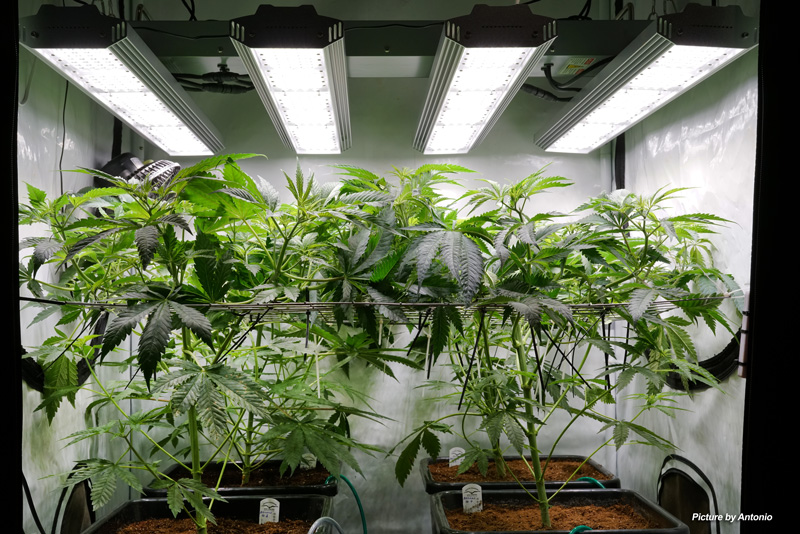
Many scroggers feel that the SCROG technique suits feminised seeds better than autoflowering seeds. Feminised seeds allow the grower to maintain the plants in the vegetative growth period for as long as necessary. In the case of e.g indica dominant strains, longer veg periods can be used to ensure the screen will fully fill during the flowering phase.
Growing autoflowering cannabis seeds with SCROG can present additional challenges. Autoflower plants have a fixed life cycle and switch into bloom when they wish to, rather than when the scrogger wants them to. This means there are less guarantees that the screen will be filled as efficiently as you might like. However one important tip is to select autoflower seeds that grow into larger plants, or those perhaps with a higher sativa content which are more likely to stretch during bloom.
If you do want to SCROG with autos, select the largest XXL genetics you can get. Dutch Passion XXL Autoflower seeds such as Auto Glueberry OG, Auto Lemon Kix, Auto Critical Orange Punch, Auto Ultimate, Auto Daiquiri Lime and Think Different would be the best recommendations.
Related products: 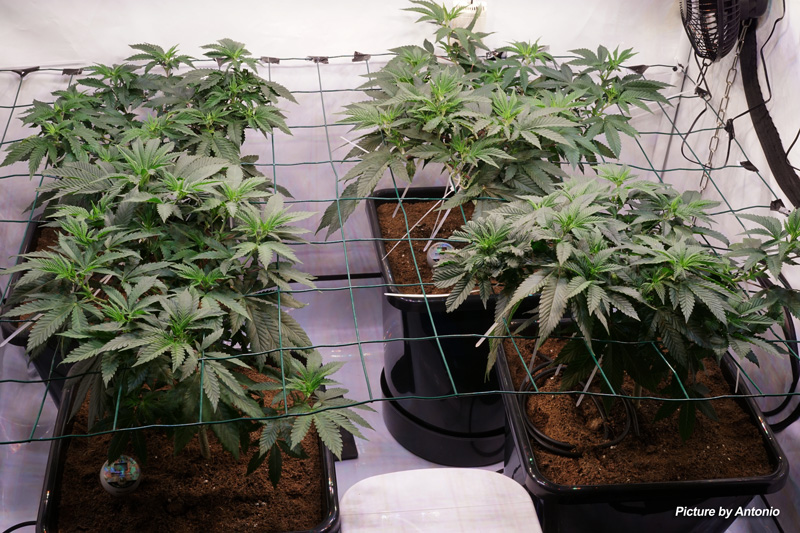 Dutch Passion’s heaviest XXL autoflower seeds
Dutch Passion’s heaviest XXL autoflower seeds
SCROG vs Sea Of Green grow method
SCROG often uses low numbers of plants with maximised growth of as many bud points as possible, often with long periods of vegetative growth. Sea Of Green (SOG) involves growing large numbers of cannabis seeds, often in small pots with minimal amount of vegetative grow time. A large number of plants (often with a dominant main cola) are grown with the SOG (Sea Of Green) method.
SCROG without topping
Although many SCROG growers prefer to top their plants, many don’t. The advantage of SCROG with a topped plant is that the plant produces lots of bushy side shoots. However, if you have a particularly stretchy and inherently bushy plant you can also get excellent SCROG results without topping your plants.
Those that prefer to SCROG with un-topped plants find that bending and weaving the branches gives much the same result, manipulating the plant into a bushy flat growth structure.
Read more : Top 5 Tips to Safely Hang Lights for the Holidays
Those that do prefer to top (or FIM) the main branch for SCROG produce a hormonal change in the plant. When you chop off the main growth tip, you remove the part of the plant with the most Auxin (plant growth hormone). With the main growth tip removed, Auxin is used in the remaining side branches which consequently grow faster following the topping.
SCROG growing method step-by-step Guide
The precise details of your SCROG grow will be determined by a few variables, such as the amount of available height as well as the power and type of grow light. A 1000W HPS grow light in a parabolic reflector might need to be up to 100cm over your canopy. A 600W water-cooled HPS could be placed much closer to your canopy. So too could an LED bar light which might need to be just 25cm over your blooms.
If you are going to try SCROG, spend a few moments considering the basics.
Step 1: Setting up your SCROG system
If the blooms grow taller than you plan it may be worth ensuring that you have spare vertical space to raise the height of your light if you need to. So rather than hang your light at maximum height in your grow tent, it could be worth saving yourself a few centimetres/inches at the top just in case you do need to raise the light at the end.
Remember to try to position your grow light so that the blooms are in the centre of the recommended lighting distance. Check the manufacturers recommendations to find the recommended hanging height of your grow light. The distance between the top of your blooms and the grow light can vary depending on the power and type of light.
When the scrogger is able to grow healthy plants with numerous blooms, all of which are growing in the optical sweet spot of maximised light intensities then spectacular results can be achieved.
How to make your own SCROG net. Make a SCROG screen
If you are growing cannabis indoors using a standard grow tent then you will find there are ready-made SCROG screens/nets that you can buy. These are usually designed specifically for the tent size, e.g. 1m x 1m.
If you are on a budget, then you can try making your own net. One easy way is to visit the garden centre/building centre and buy some green plastic garden fencing. This is often available to buy on a roll and can be cut to the size of your grow area. Metal fencing can also be bought in rolls/sheets and cut to size.
How to suspend your SCROG net, how to use a SCROG net
The ready-made SCROG nets clip/tie onto the side poles of your grow tent. If you make your own SCROG net from plastic garden fencing then you can use cable ties/tie-rips to attach the SCROG screen to your tent.
Note that not all of the ready-made SCROG nets are recommended. Some have a grid pattern that is a little too large and are only really suitable for preventing top-heavy blooms from falling over. With large, floppy grids some of the fabric nets are just not that effective for SCROG.
Many experienced SCROG masters prefer a sturdy, rigid metal SCROG net with a grid of around 5cm x 5cm. This can be bought on rolls in e.g. garden centres, or in sheets from e.g. building merchants. The extra strength/weight of the metal SCROG screen can make it easier to weave/tie the branches and keep them firmly in place.
Step 2: Vegetative cannabis growth with SCROG
The skilled scrogger will adapt the amount of vegetative time given to his plants according to the cannabis strain being grown. The idea is that the screen will be full of flowering points ready to explode in vertical growth once the plants have stopped stretching after the first few weeks of bloom.
Some stretchy sativa plants can triple in height during flowering. This makes them a favourite with many scroggers since they rapidly fill the screen. Indica dominant hybrids may only increase in height by 50%-100% during bloom. With relatively much less stretch, scroggers may prefer to grow their indica dominant strains for longer in veg in order to ensure the SCROG screen is completely filled.
As a general rule for growing a ‘typical’ hybrid with an average amount of stretch, many SCROG growers wait until the screen is around 75% full with branches and shoots before flipping to 12/12 bloom conditions. If you have a particularly stretchy sativa you might start bloom a little earlier, perhaps when around half the screen is full. If you have indica dominant hybrids then you may prefer to wait until the net is almost full before bloom. This is because indica dominant hybrids can have relatively little stretch during bloom.
However, much depends on your own grow room setup. This includes factors like the number of plants per square metre and the plant container size. Other big factors include the variety of cannabis seed used as well as the specific phenotype that you have. There is no substitute for experience. You will learn a great deal once you have some experience and have seen how your particular variety reacts to your conditions during veg and bloom.
How to irrigate your SCROG (when to start)
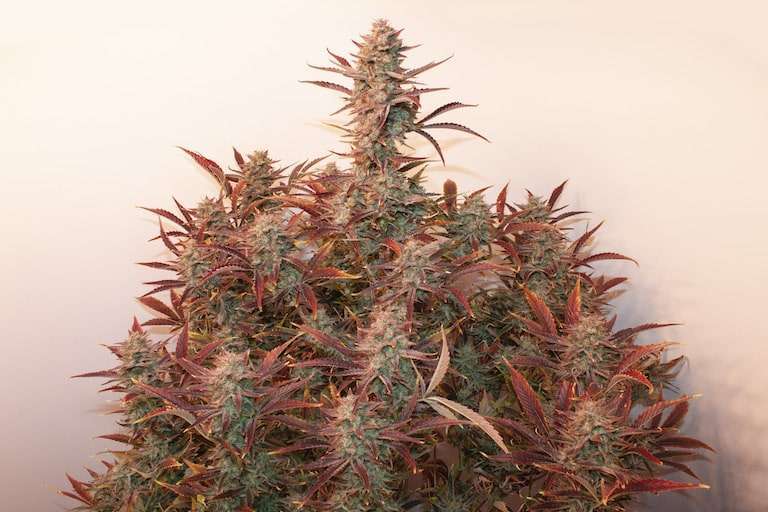
Many SCROG growers focus on growing small numbers of plants. For the typical indoor grower it’s often just a couple of plants that are grown. That allows the grower to use large containers. So in a 1.2m x 1.2m SCROG grow there may be perhaps just two grow containers to water.
It makes sense to use large grow containers, perhaps 30-50 litres in size. With such a large volume of soil/compost you have lots of nutrients for a large root mass. The fewer plants you have, the larger the containers need to be. If you wanted to grow a single plant for a 1.2m x 1.2m SCROG then a container of 70-110 litres would be best.
How do I irrigate my SCROG? Watering/feeding your plants is easy with a normal watering can. One other advantage of an organic SCROG in larger containers is that it can allow the grower to complete a full grow cycle with hardly any need to add extra nutrition. Especially if you are using organic slow release nutrients from BioTabs – something we find gives excellent results in soil or coco fibre.
When to stop tucking SCROG
Much depends on the properties of the particular variety that is being grown. Scroggers often stop weaving the branches through the screen when it starts getting difficult to do so. There is no purpose weaving branches through the screen if it is damaging the young buds.
Timing is particularly important and improves with experience. Ideally, when the net/screen is full, you will hope for numerous blooms to reach 20-40cm high above the net. Ending up with blooms that are much longer than 40cm isn’t necessary, and may be counter productive. This is because it can force the grow light further to be raised away from the canopy, compromising light intensity levels for lower bud points.
If you have a variety which stretches for around 4 weeks in bloom, you may wish to keep scrogging for the first 2 weeks when stretch is fastest. This way, you still get a couple of weeks of vertical growth which will give good sized buds/blooms without risking the blooms getting too long and stretching too close to the light.
Step 3: Training your cannabis plants under SCROG
As the stems and branches grow, keep tucking them under the screen. Note that many experienced SCROG masters these days prefer to use cable tie/tie-rips to hold the branches in place over the screen/net without actually weaving the branches through it.
This is called ‘training’ the plants. Initially there isn’t much tucking/training to do. But as the plant gets larger and reaches maximum stretch in early bloom you can find yourself busy for a few minutes each day tucking the growth tips under the screen.
It’s a very satisfying process, few sights are more rewarding to a home grower than a beautifully crafted SCROG canopy of blooms sparkling under your grow light in late bloom.
When to prune leaves SCROG
Although many growers fundamentally dislike the idea of pruning, or removing leaves, it can be essential in order to allow light to reach lower branches which are reaching up to the screen. Sativa leaves, with their typically thin fingers are well suited to SCROG. The leaf structure allow light to penetrate better than thick fingered indica strains. Scroggers often remove leaves which block light from reaching bud points.
SCROG vs Low stress training (LST)
SCROG has some similar principles to those used in low stress training (LST). With LST, string can be used to e.g. tie down the tallest blooms/branches. By trying to keep all the blooms at the optimum light intensity levels (instead of just the tallest blooms) LST mimics the principles used in SCROG.
Step 4: Trimming leaves under SCROG
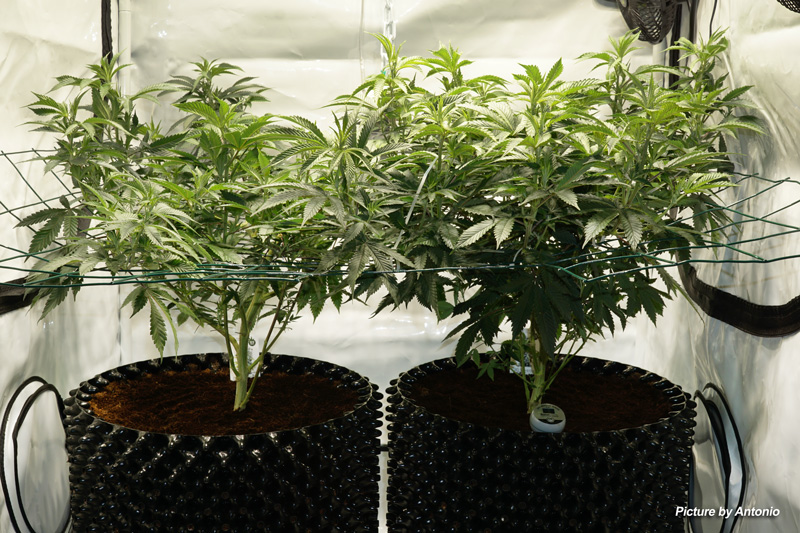
The subject of leaf trimming/removal can be controversial. Some growers never remove leaves, feeling the they perform a key function. Scrog growers may not always like removing leaves, but they know that doing so will expose more bloom points to more light. This produces heavier yields. After a couple of SCROG grows you will find the experience and confidence to navigate between too much leaf trimming and insufficient trimming.
When to trim under SCROG
It always helps if you have grown a variety before. That way you have a better understanding of how quickly she will grow, how much stretch you can expect and how much defoliation to deal with. Many scroggers are quite ruthless with leaf removal. When a leaf starts obscuring large amounts of light from the canopy it is often removed. This suggests that if limited defoliation does have a detrimental effect on plant health it is a very minor one.
What to do if your SCROG runs out of room, how many plants for SCROG?
Unfortunately running out of room can happen to the best of growers, especially if the blooms are taller and longer than expected. There are two options, either raise the light (you did leave some spare head room, right?) or to attempt to flatten the blooms.
Read more : Report: Georgia, Florida mull new neutral sites for rivalry game
Trying to flatten a canopy of growing blooms is notoriously tricky. One option is to get a second screen and lay it over the canopy, adding slight amounts of extra pressure each day to force the blooms to become progressively more horizontal.
Bending/crushing the branches can be done when the plants stretch more than expected, but remember that not all varieties react well to these techniques.
When you start to master the SCROG technique and find out how best to apply it to your particular grow room you may find that you need less plants than you first imagined. Even a first grow SCROG can see a 1m x 1m screen fully filled from a single well managed plant.
When to stop tucking SCROG
You will need to gain some experience in your own SCROG to know when to stop tucking/scrogging. Don’t expect all the answers on your first SCROG. Each set up tends to have subtle differences. How high should a SCROG net be above the plant container? It varies from grower to grower, but from 20cm to 50cm is fairly typical.
Some growers place the SCROG screen closer to their plant containers than other scroggers. This allows the plant branches to reach and fill the screen earlier. Other growers prefer a greater distance between the plant container and the net, which may result in a longer time required to fill the net. Most scroggers stop tucking only when it becomes difficult to weave the branches without damaging the young buds.
Step 5: Flowering cannabis plants in SCROG. When to flip SCROG
Your feminised photoperiod plants will switch to flowering when you reduce (or ‘flip’) daily light to 12/12 (12 hours of light followed by 12 hours of darkness). As your plants stretch you will be able to carefully continue tucking the growing shoots under the netting/screen. Some growers use cable tie/tie-rips, small clips, or wire, to hold them in place.
Eventually there reaches a point where you can’t continue to tuck any more. Stretching of the branches will stop and the plant focuses its energy on bud/resin production. As mentioned before, when growing a typical hybrid strain many people stop scrogging one week (maximum 2 weeks) before stretch finishes. This allows a full screen and some vertical growth with good sized blooms.
How much can you yield when you SCROG ?
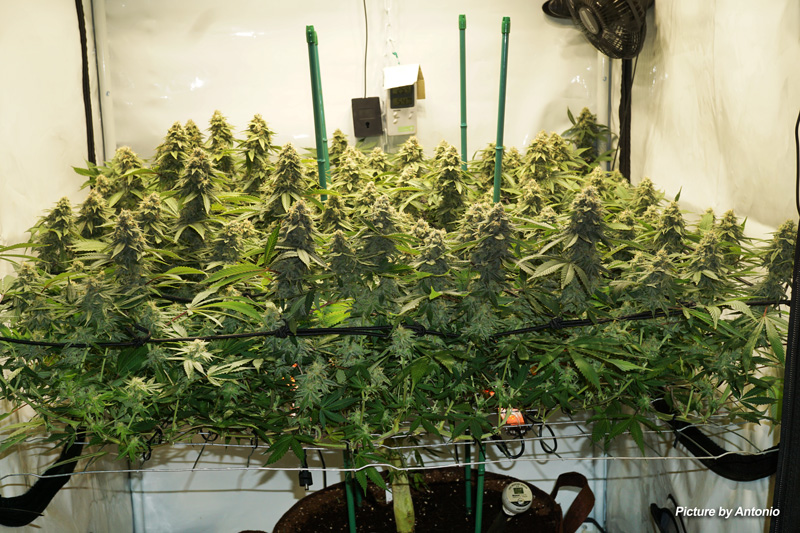
With the best cannabis seeds you can aim for 500-600g/m2. Expert growers can aim for 600-1000g/m2 in a 1m x1m or 1.2m x 1.2m area if they have a high quality LED grow light and fully optimised grow room conditions with high quality genetics.
Bear in mind that it can take you a couple of SCROG grows before you fully master the technique and are able to apply it to the specific lighting and space/height availability in your grow room. Eventually you will know which types of strains perform best for you, how long to veg them for and exactly what the best hanging height for your light is.
Useful tips to maximise your harvest
Upgrading from HPS to LED can make a huge quality difference to the final product. Clones that produce 17% THC under HPS can produce 23% THC under LED. Add a UVB light and you could be aiming for THC levels around (and even above) 25%. LED SCROG is the way to go if you can afford the initial cost of the LED.
Careful nutrient management, without under feeding or over feeding your plants is important if you are aiming for maximum yield and quality.
Growing in airpots, or fabric root pouches is proving very popular among the best growers. The extra root oxygenation results in healthier growth and heavier final yields.
Best cannabis strains suitable for SCROG
Some cannabis seeds produce plants with particularly flexible branches that are perfectly suited to the rigours of repeated tucking/training. Other strains have good internodal distances and reliable stretch levels which also make them well suited to SCROG. Many of the Dutch Passion strains will grow well in SCROG, but here are three which we really recommend.
Desfrán, cannabis cup winning pure sativa genetics
Desfrán uses sativa genetics from the multiple cannabis cup winning Latin American ‘Destroyer” strain. This is a dream strain for any SCROG grower. The flexible slender branches are easy to manipulate in a SCROG grow. The exceptionally stretchy genetics mean that your screen will fill easily and quickly. Desfrán is part of our Latin American cannabis seed collection.
If Desfrán is grown without a SCROG net it can quickly take over your grow tent, filling all available space. So a SCROG grow is a great way to control this vigorous, THC rich strain. One other great feature of Desfrán is that she is part of the Dutch Passion collection of ‘Very High THC seeds’. This means you can expect THC levels around 20%. Maybe even a little higher if you have an optimised grow room with LED grow lights and perhaps supplemental UVB light. Bloom time is generally 9-10 weeks, occasionally longer, with very heavy yields.
Related grow report: 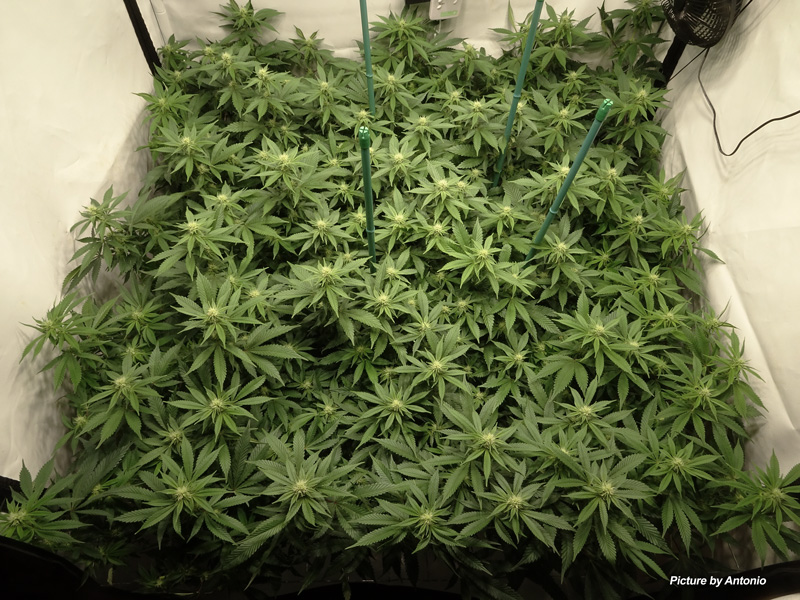 Desfrán indoor grow using soil and LED grow lights
Desfrán indoor grow using soil and LED grow lights
Outlaw Amnesia, heavy yields of THC rich Haze buds
Some SCROG growers love an Amnesia Haze variety. Not only are you guaranteed the legendary power of Haze genetics, but you can get heavy yields, a full SCROG net and an uncomplicated SCROG experience.
Outlaw Amnesia feminised seeds are made from a cross of Super Haze with an elite Amnesia Haze clone. It’s a reliable Amnesia line with very strong THC levels, around 20%. This is another member of Dutch Passion’s exclusive ‘Very High THC seeds’. Weed doesn’t get much stronger than this!
The branches are easy to bend in and out of the SCROG netting. With powerful Haze genetics there is no need to worry about fully filling the screen. Outlaw Amnesia grows with great vigour.
Outlaw Amnesia remains one of Dutch Passion’s best ever Haze strains. If you don’t mind a long bloom time (up to 12 weeks for some phenotypes) Outlaw Amnesia will reward you with some of the finest quality buds you will have ever enjoyed. With a uniquely enjoyable, soaring psychedelic high this proven Haze strain satisfies in a way that few others can. This strain is part of our ‘Classics’ cannabis seed collection.
Related grow reports:  Outlaw Amnesia seeds grown under 600W HPS in 41 litre sacks of soil
Outlaw Amnesia seeds grown under 600W HPS in 41 litre sacks of soil  4x Outlaw Amnesia seeds grown indoors under HPS grow light
4x Outlaw Amnesia seeds grown indoors under HPS grow light 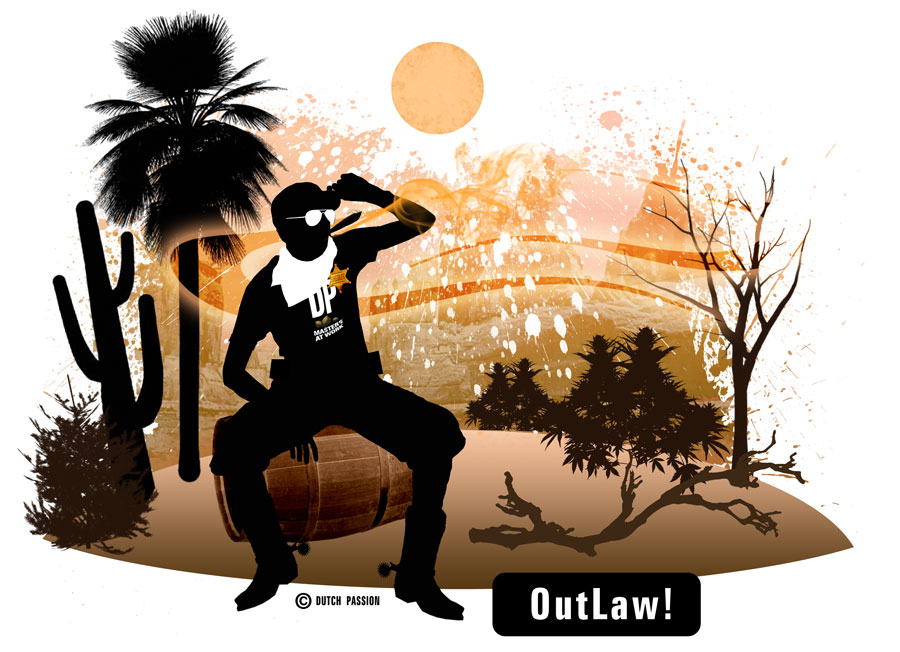 OutLaw Amnesia seeds grown indoors with HESI nutrients under 600W HPS
OutLaw Amnesia seeds grown indoors with HESI nutrients under 600W HPS
Power Plant, South African sativa with legendary strength
Any recommendation for a top quality SCROG strain isn’t complete without original South African Power Plant seeds. This THC rich home growers legend is available in regular cannabis seeds as well as feminised seeds. She is famous for quickly producing her heavy yielding chunky blooms which are frosted in a beautiful white resin coating.
The high is exquisitely pleasurable and powerful in equal measure. Expect a deep cerebral high and an enjoyable body effect with long lasting effects. Power Plant has remained on our customer best seller list for all the right reasons. She is easy to grow, her inherently stretchy growth pattern is ideally suited to SCROG. The branches quickly fill the screen and the resin soaked blooms grow rapidly.
Bloom time is 8-10 weeks, the blooms can reach 30cm long with small leaves in them. Power Plant is another cannabis cup winner with a proven heritage and guaranteed quality. For many growers Power Plant has earned her reputation as one of the quickest sativa strains which doesn’t compromise on quality or quantity. Yields can be exceptionally heavy.
Related grow reports:  Power Plant grow review by TheCannaProphet
Power Plant grow review by TheCannaProphet  Power Plant grown from seed to harvest under 12/12 light
Power Plant grown from seed to harvest under 12/12 light 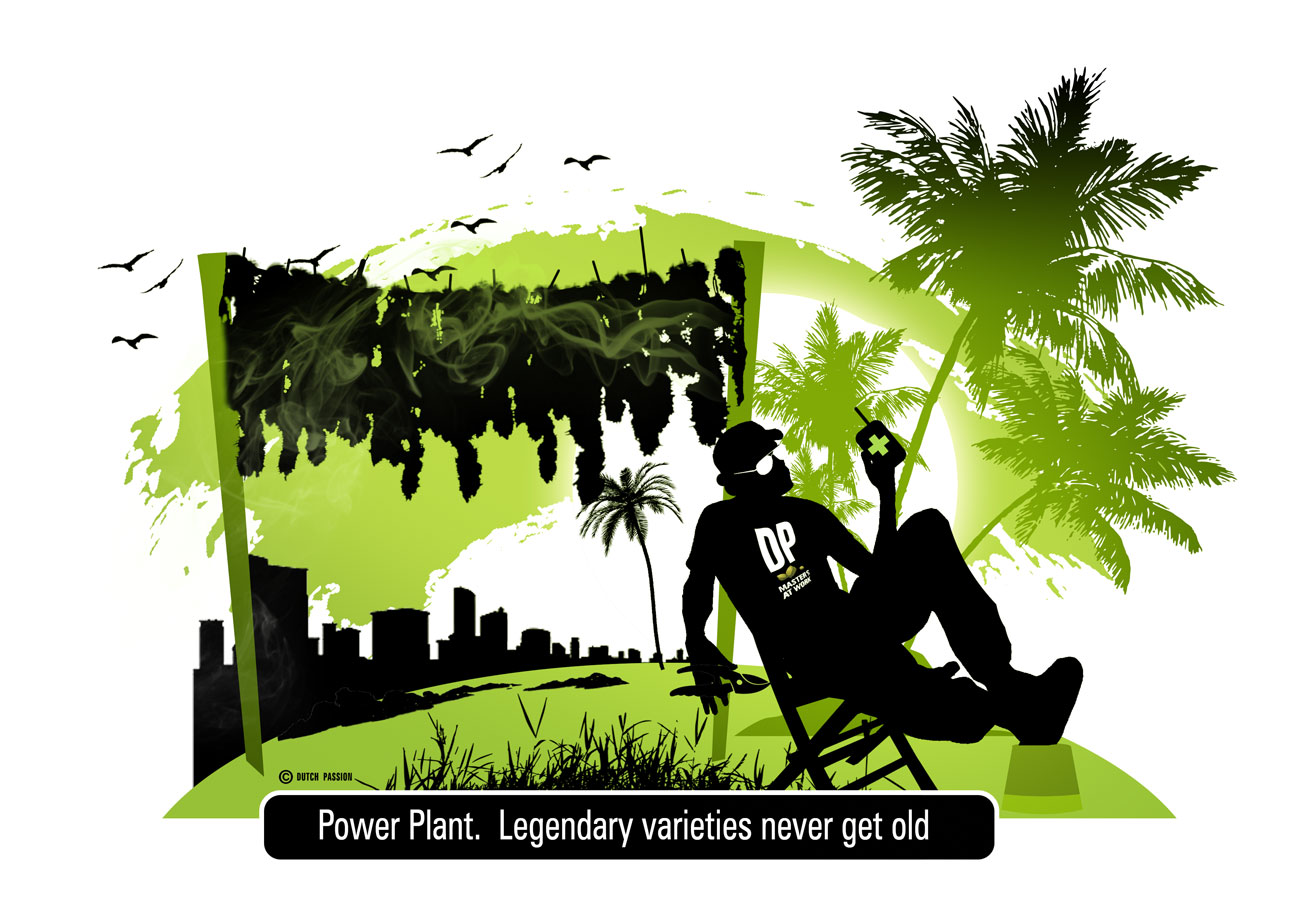 Power Plant 20 years high THC Sativa
Power Plant 20 years high THC Sativa
How to SCROG with maximum yield

SCROG is a technique which can transform your indoor harvest potential. It’s important to use high quality, heavy yielding cannabis seeds from a seedbank with a reputation for consistent, reliable results.
But it’s equally important to recognise that your experience and ability to improve and optimise your grow room is just as vital to the final results that you can achieve.
You will achieve exceptional harvests if you can master the SCROG technique while keeping your plants in the nutrient sweet spot in an optimised grow room with maximised light levels. Good luck, and enjoy your SCROG grow!
Related grow guides: 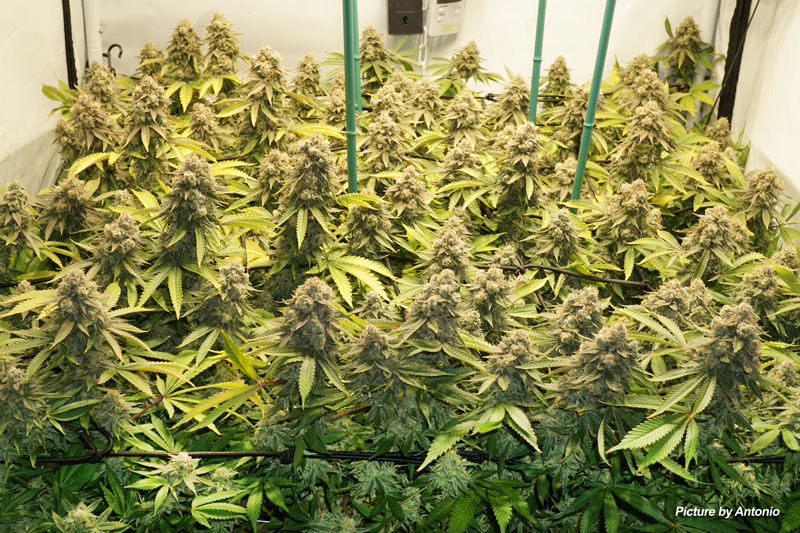 How to optimise your grow room
How to optimise your grow room 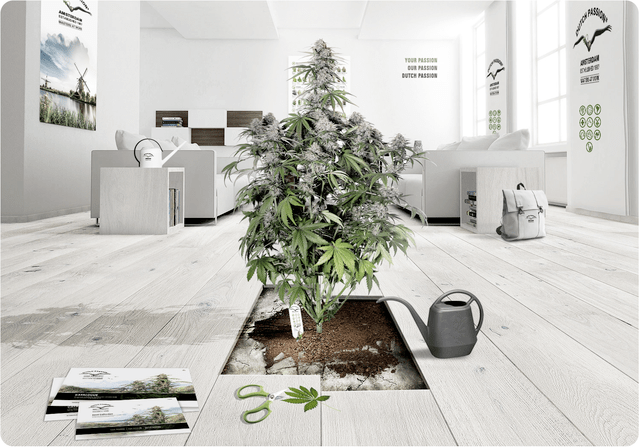 Indoor cannabis growing
Indoor cannabis growing
Source: https://gardencourte.com
Categories: Outdoor


